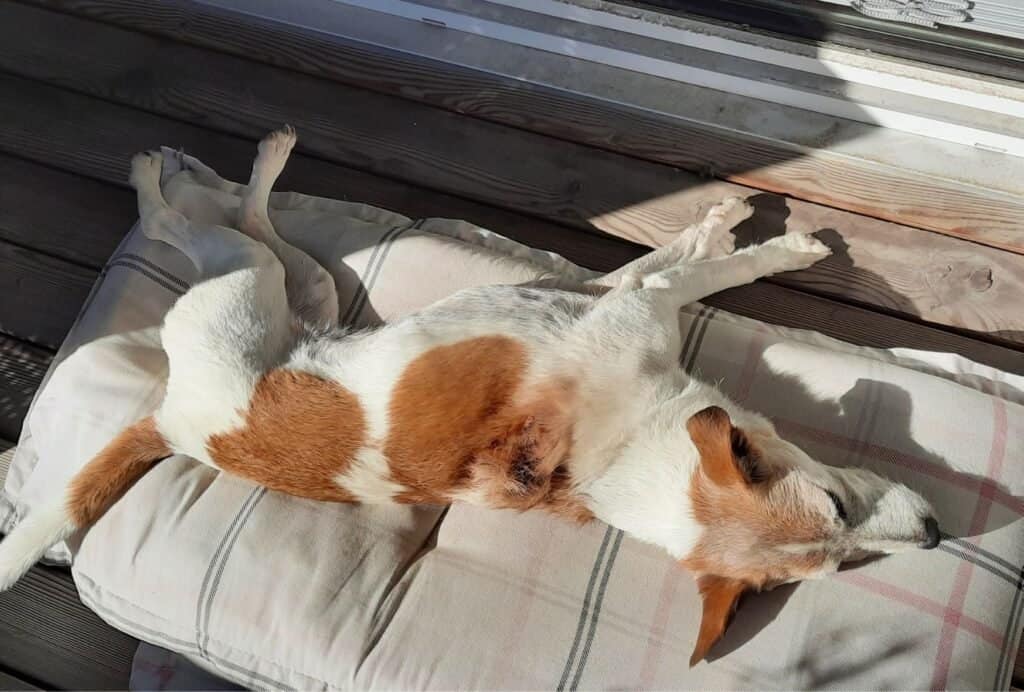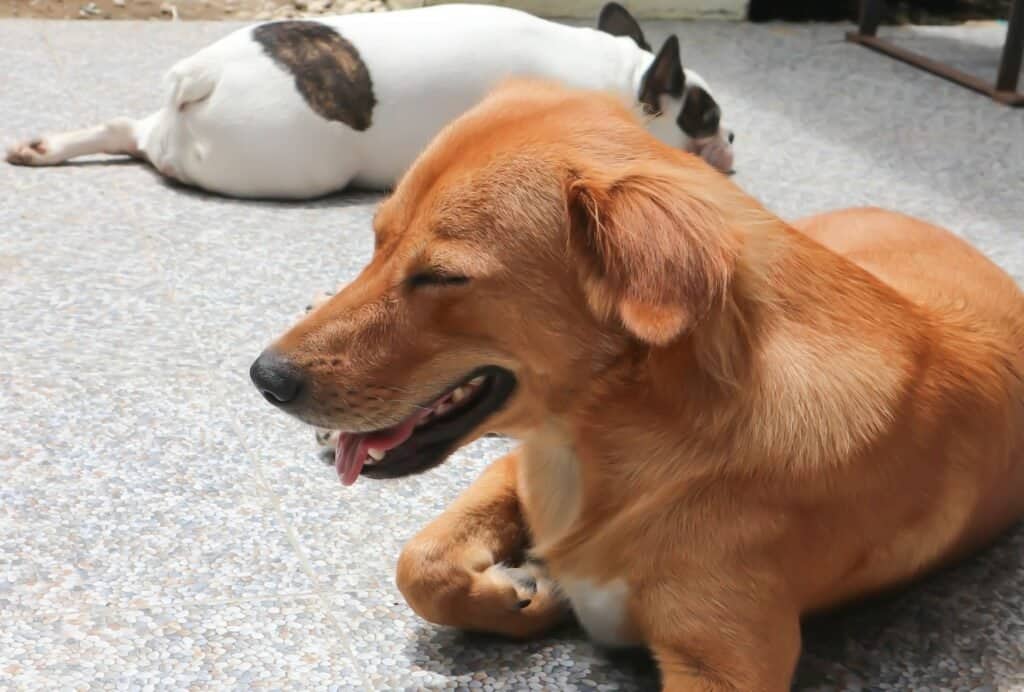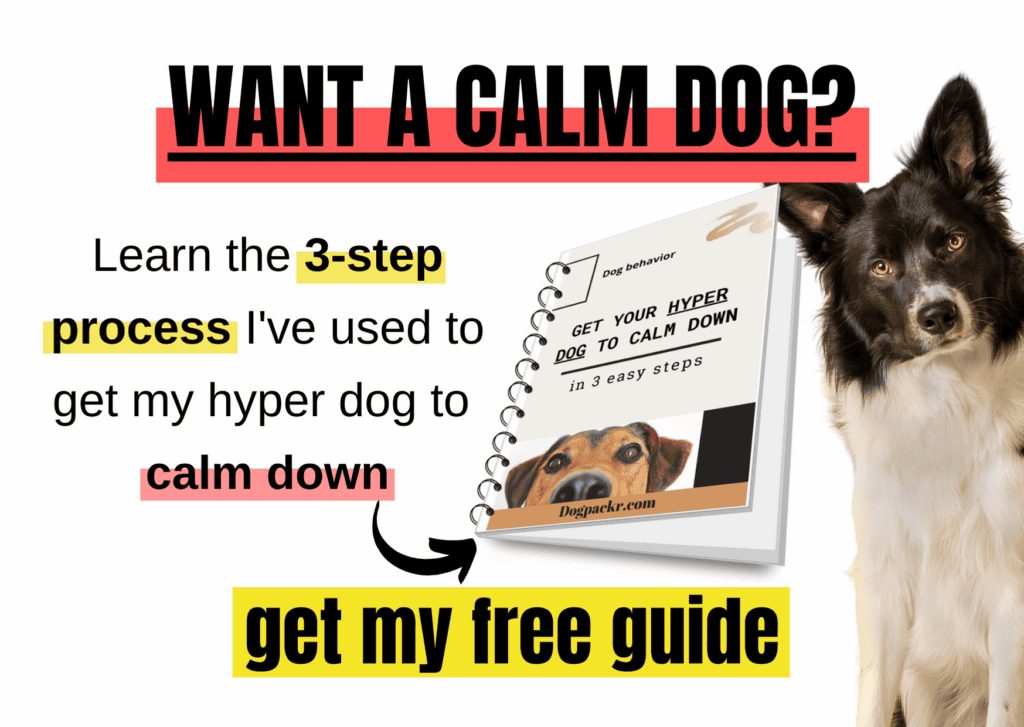
I’m always amazed at how my black Mini Poodle loves to lay in the sun. He can lay there for up to half an hour even when it’s super hot and he’s not even panting!
When he comes back inside his fur is super hot but he doesn’t seem to mind. In fact, he mostly goes to his bed and takes a nice, long nap.
I was always wondering why he’s doing that and how this can be comfortable.
So, here’s what I found. In short: Dogs and humans get vitamin D from sunlight, which helps fight depression and fight off diseases. But it also produces serotonin, which is a hormone that helps us and dogs be more relaxed, focused and happy. Another reason dogs like to sunbathe is because it has an anti-bacterial effect. Dogs usually instinctively know how much sunshine they need, so you don’t need to worry.
Now let’s take a closer look at this topic:
Table of Contents
Why Do Dogs Like to Lay in the Sun?
You’ve probably noticed your dog lying out in the sun on a warm day, or following sunbeams around the house.
So why do dogs like to lay in the sun so much? Let’s go over some of the reasons.
Resting
If your dog wants to take a break, he’ll probably find a nice patch of sunlight to lie down in. Lying in the sun feels restful for your dog, just like it does for us!
When we lie in the sun, we feel relaxed and calm. The same is true for your dog. So next time you catch your dog lying out in the sun, know he’s probably just getting a little rest and relaxation in!
Warmth
Just like humans, dogs enjoy sitting in the sunlight for warmth. There’s a reason both dogs and humans like to sunbathe. The warmth feels good on our skin!
Lying out in the sun also helps regulate a dog’s body temperature, which is especially helpful during cooler seasons. If your dog is older or has any joint pain, sunlight and warmth will help lessen that pain.
Vitamin D
Vitamin D is also called the “sunshine vitamin,” because sunlight is what makes our skin produce the vitamin.
Related article: 5 signs of dog depression
For both humans and dogs, vitamin D helps to reduce depression and fight off diseases. It also helps to encourage bone growth by absorbing phosphate and calcium.
While vitamin D is important for both dogs and humans, too much vitamin D can be toxic for dogs. Too much vitamin D can cause problems with joint, kidney issues, and vomiting. That’s why it’s important to keep an eye on your dog when he’s out in the sunlight. More on that later!

Serotonin
Being in sunlight is also thought to increase the levels of serotonin in both dogs and humans. This is a hormone that our brains produce that make us feel relaxed and focused. It also makes us and our dogs feel happier!
So next time you see your dog looking especially tranquil in a patch of sunlight, consider joining him to get your own serotonin levels up!
Microbial Effect
As it turns out, making us and our dogs happier and less depressed isn’t the only health benefit of the sun. Sunlight can play an anti-bacterial role, which helps a dog’s skin stay clean and healthy.
Sunlight is able to kill yeast and bacteria that grows on your dog. This will stop any bacteria on your dog from spreading any further, which will keep your dog healthy!
And the best part? You don’t even have to spend any money on this anti-bacterial remedy.

Is It Bad for Dogs to Sunbathe?
Overall, it’s good for dogs to be in the sun. Sunlight helps produce serotonin, keeps dogs warm, and helps get rid of unwanted bacteria and microbes.
Dogs are also pretty instinctive, and know naturally how important and helpful getting sunlight is.
You should let your dog lay in the sun if they choose to do so. At the same time, you should also always make sure that they have enough clean, fresh water close by so they can stay hydrated. Also make sure that there’s a shady spot nearby that’s available once they’ve had enough of the sun.
Remember to keep an eye on your dog while he’s outside to make sure he isn’t spending too much time in the sun and heat.

How Much Sun Does a Dog Need Daily?
When it comes to how much sun your dog should be getting daily, you’ll find many different numbers.
Most experts will recommend that your dog gets somewhere between 20 to 30 minutes of sunlight twice a day. Larger breeds might need closer to 40 minutes twice a day.
The time of day when your dog is getting sunlight is also important. The amount of sunlight your dog gets, and the kind of sunlight he gets, will affect your dog’s circadian rhythm.
During different parts of the day, the sun produces different levels of UV and UVB light. These types of light play an important role in your dog’s circadian rhythm. Because of this, it’s best to let your dog out in the sun for his first 30 minutes or so in the morning, 15 minutes in the middle of the day, and then his last 30 in the afternoon or evening.

How Long Should I Let My Dog Lie in the Sun?
Just as it’s important to make sure that your dog gets enough sunlight, you should also make sure that he isn’t getting too much.
Too much sun can cause health problems for your dog. As a general rule, if you’d had enough of sitting out in the sun, you can bet your dog has had enough too.
However, most dogs will instinctively know when it’s good for them to lay in the sun. So, as long as he isn’t lying in the sun for the whole day, there’s usually nothing to worry about.
Potential Dangers of Too Much Sunlight
Since being in the sun for too long can cause health problems for your dog, it’s important to understand what those health problems are and how to avoid them.
Heat Exhaustion
When humans get hot our bodies sweat to help us regulate our body temperatures.
Dogs, on the other hand, don’t sweat. Instead, they pant. But even though panting will help your dog regulate his body temperature, that doesn’t mean he’s immune from overheating.
The signs of heat exhaustion are pretty easy to spot. Your dog might start panting excessively, be extremely thirsty, drool, be lethargic, dizzy, experience muscle tremors, or start vomiting or having diarrhea.
If you notice any of these symptoms, it’s important to get your dog out of the heat right away, and give him some clean water to drink.
To avoid heat exhaustion, make sure your dog doesn’t stay outside for too long, especially on hot days.
Never leave your dog inside of a parked car! And try not to walk him during the hottest parts of the day.
Heat Stroke
Heat stroke is a very dangerous condition that occurs when your dog’s body temperature reaches 106°F (41°C) or over. At this point, your dog’s internal cooling system will start to fail because it’s been so overwhelmed by the heat.
Once this goes, other parts of your dog’s internal system start to fail too. This includes your dog’s circulation and neurologic systems.
If your dog has heat stroke, he might start vomiting or having diarrhea, which might have blood in it. He might start walking unevenly, or collapse completely, and be unresponsive to you. Heat stroke can also cause seizures.
Heat stroke is usually the next step after heat exhaustion. That’s why it’s incredibly important to get your dog indoors or over to some shade as soon as he starts showing any signs of being overheated!
Once your dog reaches heat stroke, and his internal circulation and neurologic systems start to fail, it can be hard for your dog to recover.
If your dog shows signs of heat stroke, don’t worry about any at-home remedies. At this point, you need to get to your vet straight away!
Skin Cancer
Just like humans, excessive sunlight can cause skin cancer in dogs. Even though your dog is covered in fur, that fur doesn’t protect him completely from the sun’s rays.
There are several different types of skin cancer that might affect your dog. Certain breeds tend to be more at risk of skin cancer too. Dobermans, Miniature Schnauzers, and Scottish Terriers tend to be mostly affected by benign melanomas.
On the other hand, the more aggressive squamous cell carcinoma mostly affects Collies, Basset Hounds, and Beagles.
If you spot any abnormal patches on your dog’s skin, that’s a sign he might have skin cancer. Depending on the type of cancer, these patches might be raised and colored red, brown, black, or grey. They might also appear like warts, or appear as inflamed patches.
If you think your dog might have skin cancer, it’s important to take him to the vet right away to get a diagnosis. Remember, the earlier you can catch skin cancer, the easier it will be to treat it!
Conclusion
Lying in the sun is a totally normal, healthy thing for your dog to do. It stimulates the production of serotonin, which makes your dog happy and relaxed. It keeps your dog warm, and lying in a nice sunny patch is incredibly relaxing and restful.
At the same time, it’s important to watch your dog, and make sure he doesn’t get too much sun. This can lead to heat exhaustion and, at worst, heat stroke, which is incredibly dangerous and possibly fatal. You should also make sure your dog doesn’t show any signs of skin cancer.
When your dog is outside, always remember to provide him with clean, fresh water to stay hydrated, and shady areas for when he gets too hot.
And remember to spend some time out there yourself—the sun is good for you and your dog!
*Disclosure: This post may contain affiliate links, meaning, I get a commission if you decide to make a purchase through one of my links, at no cost to you.


